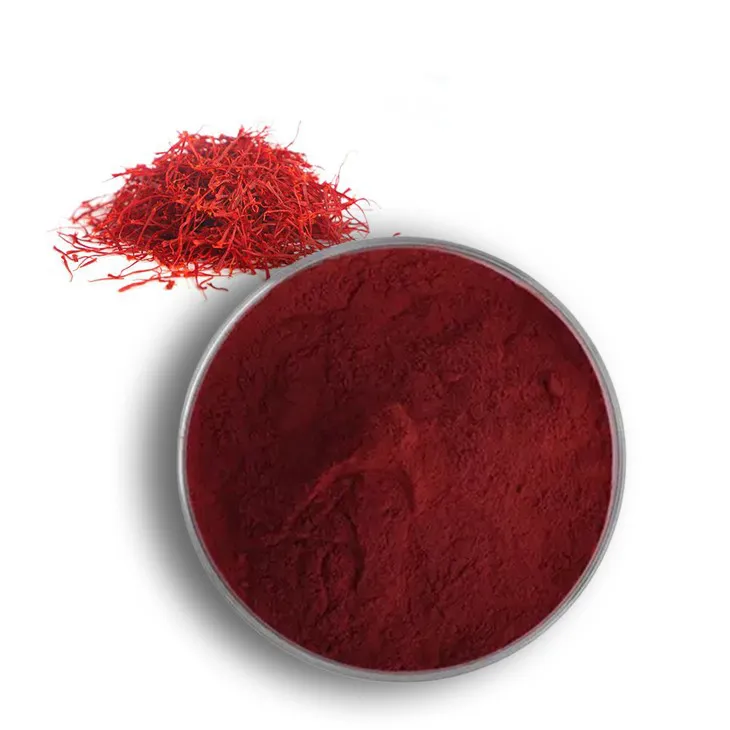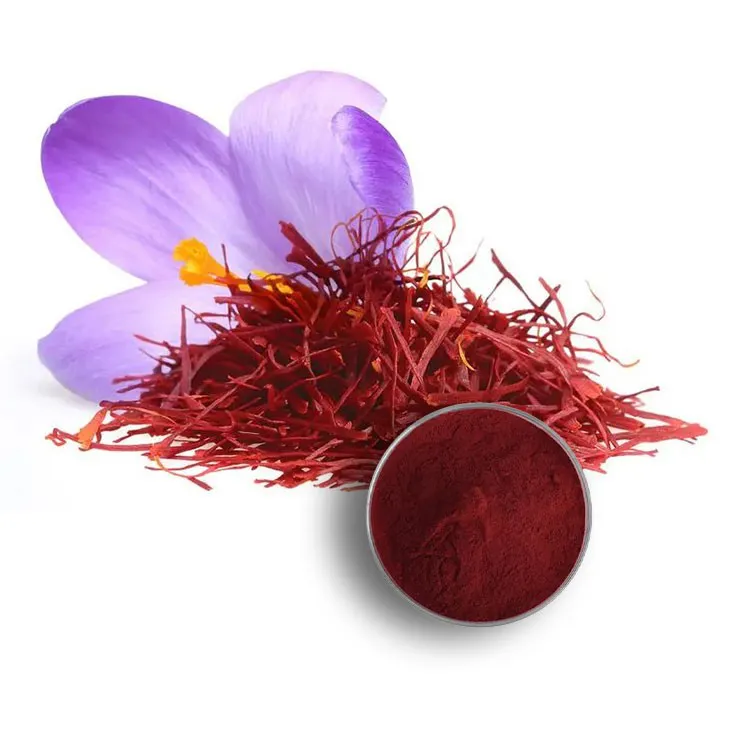- 0086-571-85302990
- sales@greenskybio.com
Extraction Technology and Production Process of Saffron Extract Powder.
2024-11-30

1. Introduction
Saffron, one of the most precious spices in the world, has been used for centuries in various applications such as cooking, medicine, and perfumery. Saffron Extract Powder is derived from saffron stigmas and contains a variety of valuable components, including crocin, picrocrocin, and safranal. These components are responsible for the unique color, taste, and aroma of saffron, as well as its potential health benefits. In this article, we will explore the extraction technology and production process of Saffron Extract Powder in detail.

2. Extraction Technology
2.1 Traditional Extraction Methods
Maceration is one of the traditional extraction methods for saffron. In this method, saffron stigmas are soaked in a solvent, usually ethanol or water, for a certain period of time. The solvent penetrates the plant material and dissolves the active components. The main advantage of maceration is its simplicity and low cost. However, it is a time - consuming process, and the extraction efficiency may not be very high.
Soxhlet Extraction is another traditional technique. It involves continuous extraction of saffron with a solvent. The saffron sample is placed in a Soxhlet extractor, and the solvent is repeatedly evaporated and condensed over the sample. Soxhlet extraction can achieve a relatively high extraction rate compared to maceration. However, it also has some drawbacks. For example, it requires a large amount of solvent, and the high - temperature extraction process may cause degradation of some heat - sensitive components.
2.2 Modern Extraction Methods
Ultrasonic - Assisted Extraction has emerged as an advanced extraction method for saffron. In this process, ultrasonic waves are applied to the extraction system. The ultrasonic waves create cavitation bubbles in the solvent, which collapse violently and generate high - pressure and high - temperature micro - environments. These micro - environments enhance the mass transfer between the solvent and the saffron stigmas, thus increasing the extraction efficiency. Ultrasonic - assisted extraction has several advantages, such as shorter extraction time, lower solvent consumption, and better preservation of active components.
Supercritical Fluid Extraction (SFE) is also a modern and promising method for saffron extraction. Supercritical fluids, such as carbon dioxide, are used as solvents. Supercritical CO₂ has properties between a gas and a liquid, which can penetrate the saffron matrix easily and selectively extract the target components. SFE is a clean and green extraction technology, as the supercritical fluid can be easily removed from the extract by reducing the pressure, leaving no solvent residue.

3. Production Process
3.1 Raw Material Selection
The quality of saffron stigmas as the raw material is crucial for the production of high - quality Saffron Extract Powder. Saffron should be sourced from reliable suppliers, and the stigmas should be carefully selected to ensure their purity, freshness, and high content of active components. Only the red stigmas of saffron are used for extraction, as they contain the highest concentration of valuable substances.
3.2 Pretreatment
Before extraction, the saffron stigmas usually need to be pretreated. This may include cleaning to remove impurities such as dust and soil, and drying to reduce the moisture content. Drying should be carried out at a proper temperature and humidity to avoid the degradation of active components.
3.3 Extraction
Depending on the selected extraction method, the extraction process is carried out. For example, if ultrasonic - assisted extraction is used, the saffron stigmas are placed in an extraction vessel with the appropriate solvent, and ultrasonic waves are applied for a specific time period. During the extraction process, parameters such as extraction time, solvent concentration, and temperature need to be carefully controlled.
3.4 Filtration
After extraction, the resulting extract contains not only the active components but also some solid particles. Filtration is necessary to remove these solid impurities. Different types of filters, such as filter papers or membrane filters, can be used depending on the required purity of the extract.
3.5 Concentration
The filtered extract usually has a relatively low concentration of active components. Concentration is carried out to increase the content of valuable substances in the extract. This can be achieved by methods such as evaporation under reduced pressure. During the concentration process, care should be taken to avoid over - concentration, which may lead to the precipitation or degradation of some components.
3.6 Drying
To obtain saffron extract powder, the concentrated extract needs to be dried. Drying methods such as spray drying or freeze - drying can be used. Spray drying is a rapid and cost - effective method, which converts the liquid extract into a powder form by spraying it into a hot drying medium. Freeze - drying, on the other hand, can better preserve the activity of the components, but it is more expensive and time - consuming.
3.7 Quality Control
Throughout the production process, strict quality control measures are essential. Quality control includes testing the raw materials, intermediate products, and final products for parameters such as purity, active component content, and microbial contamination. Analytical techniques such as high - performance liquid chromatography (HPLC) are often used to determine the content of crocin, picrocrocin, and safranal in the saffron extract powder.

4. Applications of Saffron Extract Powder
4.1 Nutraceuticals
Saffron extract powder has potential health - promoting properties, which make it suitable for use in nutraceuticals. It has been reported to have antioxidant, anti - inflammatory, and antidepressant effects. In the nutraceutical industry, saffron extract powder can be formulated into various products such as dietary supplements, functional foods, and beverages.
4.2 Perfumery
The unique aroma of saffron, mainly due to the presence of safranal, makes saffron extract powder a valuable ingredient in perfumery. It can be used to add a warm, spicy, and floral note to perfumes, colognes, and other fragrant products.
4.3 Cosmetics
Saffron extract powder also finds applications in cosmetics. Its antioxidant and anti - inflammatory properties can help protect the skin from damage caused by free radicals and inflammation. It can be incorporated into skincare products such as creams, lotions, and serums.
5. Conclusion
The extraction technology and production process of saffron extract powder play a crucial role in obtaining a high - quality product with valuable components. Traditional and modern extraction methods each have their own advantages and disadvantages, and the choice of extraction method depends on various factors such as cost, efficiency, and product requirements. The production process involves multiple steps, from raw material selection to quality control, and each step needs to be carefully carried out to ensure the quality, purity, and efficacy of the saffron extract powder. With its diverse applications in nutraceuticals, perfumery, and cosmetics, saffron extract powder has a broad market potential.
FAQ:
What are the main traditional extraction methods for saffron extract powder?
The main traditional extraction methods for saffron extract powder are maceration and Soxhlet extraction. Maceration involves soaking saffron in a solvent for a certain period to allow the extraction of its components. Soxhlet extraction is a continuous extraction method that can more thoroughly extract the desired substances from saffron.
How does ultrasonic - assisted extraction work in saffron extract powder production?
Ultrasonic - assisted extraction uses ultrasonic waves to create cavitation in the solvent. These cavitation bubbles collapse, generating high - pressure and high - temperature micro - environments. This helps in breaking the cell walls of saffron more effectively, facilitating the release of valuable components into the solvent, thus increasing the extraction efficiency compared to traditional methods.
Why is strict parameter control important in the production process of saffron extract powder?
Strict parameter control in the production process of saffron extract powder is essential because it directly affects the product's quality, purity, and efficacy. Parameters such as temperature, extraction time, solvent type, and solvent - to - material ratio can influence the extraction yield and the chemical composition of the final product. For different markets like nutraceuticals and perfumery, products with consistent quality and specific properties are required, so precise control over these parameters is crucial.
What valuable components are typically found in saffron extract powder?
Saffron extract powder typically contains valuable components such as crocin, picrocrocin, and safranal. Crocin is responsible for the color of saffron and also has antioxidant properties. Picrocrocin contributes to the bitter taste of saffron, and safranal is mainly associated with its aroma.
How is the purity of saffron extract powder determined?
The purity of saffron extract powder can be determined through various analytical methods. High - performance liquid chromatography (HPLC) is commonly used to separate and quantify the different components in the extract, which can help in assessing its purity. Spectroscopic techniques like ultraviolet - visible spectroscopy can also provide information about the purity based on the absorption spectra of the components present in the powder.
Related literature
- Optimization of Saffron (Crocus sativus L.) Extract Production Using Response Surface Methodology"
- "Advanced Extraction Techniques for Saffron Bioactive Compounds"
- "Saffron Extract: Composition, Properties and Applications in the Nutraceutical and Perfumery Industries"
- ▶ Hesperidin
- ▶ Citrus Bioflavonoids
- ▶ Plant Extract
- ▶ lycopene
- ▶ Diosmin
- ▶ Grape seed extract
- ▶ Sea buckthorn Juice Powder
- ▶ Fruit Juice Powder
- ▶ Hops Extract
- ▶ Artichoke Extract
- ▶ Mushroom extract
- ▶ Astaxanthin
- ▶ Green Tea Extract
- ▶ Curcumin
- ▶ Horse Chestnut Extract
- ▶ Other Product
- ▶ Boswellia Serrata Extract
- ▶ Resveratrol
- ▶ Marigold Extract
- ▶ Grape Leaf Extract
- ▶ New Product
- ▶ Aminolevulinic acid
- ▶ Cranberry Extract
- ▶ Red Yeast Rice
- ▶ Red Wine Extract
-
Marigold Extract
2024-11-30
-
Hericium erinaceus extract powder
2024-11-30
-
Curcumin
2024-11-30
-
Mulberry leaf Extract
2024-11-30
-
Beta Carotene
2024-11-30
-
Grapefruit Seed Extract Powder
2024-11-30
-
Elderberry Extract
2024-11-30
-
Saponin Extract
2024-11-30
-
Dandelion Leaf Extract
2024-11-30
-
Tongkat Ali Extract Powder
2024-11-30





















